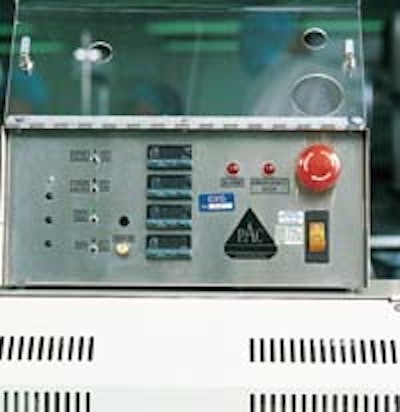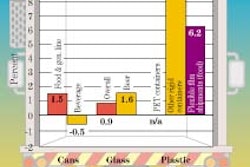In 1997, ISO11607, Section 5, mandated that all equipment used to package sterile medical products be validated. This, says Jim Sparks, senior packaging engineer for Baxter Healthcare CVG (CardioVascular Group) in Irvine, CA, was the impetus behind a major program that led to the development of two pouch sealers from Packaging Aids Corp. (San Rafael, CA).
Baxter’s CVG (soon to be known as Edwards LifeSciences) packages a variety of medical devices, from catheters to heart valves, into a variety of flexible pouches or trays that will be post-package sterilized. Most of the products are hand-loaded into premade pouches and then sealed. This packaging is very labor-intensive, Sparks says. Most packages are sterilized via ethylene oxide or autoclave, although some packs are gamma-sterilized.
The ISO document specified the parameters of the machinery operation that needed to be validated. In essence, “validation” means guaranteeing or proving the repeatability and consistency of the process parameters.
At the time, the state-of-the-art in medical pouch sealers permitted regular calibration of certain seal-process parameters, but not on an ongoing basis. In fact, calibration might be undertaken every six months, unless the output of that machine experienced problems. This didn’t pose any safety issue, because all packages were visually inspected, and a certain number were regularly subjected to physical tests.
After evaluating the ISO document, Baxter’s packaging research staff began work with Packaging Aids Corp. That led to the development of the Medpack and Medvac impulse sealers and a new Model 552 band sealer. All three machines have totally redesigned control systems that permit the company to program set points and tolerances for sealing parameters like time, temperature, pressure and conveyor speed.
Should any of these validated parameters drift out of programmed tolerance range while in production, the machine shuts down and sounds an alarm. The shutdown and alarm are handled automatically, without an operator having to monitor any gauges or print-outs.
The result has been so favorable that Baxter began putting these sealers into all of its CVG plants. “The huge Puerto Rico plant was our first target, and we put about 15 sealers there,” says Sparks. “We’ve also converted our plant in Switzerland, and now we’re working on our domestic facilities. Overall, we’ve probably purchased about 25 new machines.”
In developing the new sealers, the equipment wasn’t the only factor that needed to be considered. Packaging material and its construction were also critical. “It’s a lot like developing a capability for Statistical Process Control,” says Mark Goldman of PAC. “A company needs to identify the primary parameters of the process and then look at how each interrelates. Then a company needs to determine an acceptable range, so that when all parameters are within tolerance, you guarantee a good process output.”
The crux of the change, says Sparks, is when seal problems are discovered. In the past, he says, if one parameter started going out of tolerance and would affect the seal, a company had virtually no way to know until the packages were inspected.
“Sure we were inspecting,” he recalls. “We performed peel tests on the seal back then. But for the machine operator, there was no way to know when the seal was falling out of spec, for example.” By no means was Baxter alone; the state-of-the-art in pouch sealers as recently as three years ago offered relatively modest control over sealing parameters.
Simplify calibration
The first step in creating new models of sealers that would help Baxter’s packaging researchers in validation was to make the sealers easier to calibrate.
At the time of the ISO standard, Sparks says most of the equipment makers rushed out with what they called “validatable sealers.” However, on closer examination, there was no way to prove validation, he recalls. “For example, how can you validate a timer without using a stopwatch? The companies told us, ‘In theory, this is how it works.’ We responded, ‘Theory is great, but we have to prove it!’”
This was the point that separated the men from the boys, the engineer reports. “Only a couple of OEMs actually went back to their engineers and got them working on what we needed. For example, providing a machine with external ports for calibration instruments to plug into. This meant not just supplying a machine, but also the means to validate it.”
Baxter has had good experience using PAC machines in the past. “Our people were familiar with their machines, so PAC was one of our first choices to work with,” Sparks points out. “Plus, the company was very receptive to our ideas about what we needed for validation.”
The Medpac and Medvac impulse sealers from PAC are equipped with ports that allow Baxter to plug an electronic stopwatch directly into the machine to calibrate that machine’s timer. “Instead of using a finger to operate the stopwatch, the electronic version operates off the relay circuit. We were getting repeatability within 40 milliseconds,” Sparks claims. “This made the job of validating the equipment far easier.”
Thermocouples for temperature
The temperature-controlling device, a thermocouple, lets Baxter program in the acceptability range—the tolerance levels around the ideal temperature—along with visual alarms triggered at each end of the range, says PAC’s Goldman.
A thermocouple, Sparks adds, allows the seal to move from one that’s totally time-dependent to one that’s temperature-dependent with a time factor. “With the thermocouple, the machine measures the heat of the sealing wire, so the ‘ramp time’—the time to reach sealing temperature from latent temperature—will change, depending on the temperature of the wire.
“What this means is that the machine’s timing doesn’t start when the operator hits the pedal. The timing starts when the thermocouple says the temperature is proper. So the thermocouple automatically adjusts for the latent temperature in the seal wire,” Sparks notes.
Not only does this coordinate the time and temperature conditions, but it also usually allows an increase in machine output because the “ramp time” should decrease dramatically when the machine is operated at a high rate of speed. Because the machine automatically adjusts for the increasingly shorter time for temperature recovery, it permits faster production.
Minimizing ‘clears’
At the same time, this coordination of time and temperature can help to reduce or even eliminate some of the rejects caused by lock-up seals.
As Sparks describes, the previous method was time-dependent. “With the former equipment, you set a timer, and regardless of the temperature, the jaw would close and seal for a predetermined length of time and then open up.
“But if the seal-head temperature was building up, the residual seal temperature could be increasing,” Sparks reports. “In essence, you would set up your machine and the first several seals would be fine. But as you continued production, depending on the operator’s speed, the package seals would begin to ‘clear.’”
That term refers to overdoing or “overcooking” a seal that involves a spun-bonded material like DuPont’s (Wilmington, DE) Tyvek™, which is used for its “breathability” so that ethylene oxide (EtO) can enter to sterilize products in a pouch or tray. When too much heat is applied to a spun-bonded material, it melts it and smoothes out the fibers to let light pass through. That’s why it’s called a “clear.”
There’s nothing wrong with the integrity of the seal, but it’s a long way from being peelable. The extra heat has the effect of welding the two materials together. With a conventional peelable seal employing a spun-bonded material, the white color of the weave will reflect light back and not look clear.
Normal seal spec
Understanding what’s going on with equipment and packaging materials is a learning experience, according to Sparks. “Years ago, an industry standard of from one to three pounds was recommended as the ideal seal strength for a peelable heat seal. So in our lab, we’d set up our machines to produce a nice two-pound seal. We’d make a seal, inspect it closely and make another one. And they tested just perfectly.”
But those results could not be completely translated onto the production floor. There, Sparks says, workers are pumping out sealed pouches as fast as they can. The result soon becomes pouches with extremely high pressure required to open them, making them rejects. “That’s when we learned what was really happening with the equipment and began to understand that operating speed had a lot to do with seal strength,” he says. “That’s why the adjustability of the thermocouple allows us to operate at any speed and still know that our seal strength will stay in spec.”
The other key to consistency is the alarm function. The new sealers will alert the operator via an alarm and shut down if one or more of the seal parameters drifts beyond the tolerances that are preset. “This factor alone has led us to far more consistent seals,” stresses Sparks.
On the sealers for Baxter, each machine employs visual alarms, though Goldman says the sealers can also offer audible alarms too. In addition, because Baxter often uses dissimilar materials on each side of the pouch, PAC supplied the sealers with an option to heat either or both seal jaws. This is true both for impulse and band sealers.
Special shut-down systems
While the impulse sealers can just shut off the seal-jaw activation when a parameter is out of tolerance, the continuous heat and conveyor of a band sealer make that impractical. On some band sealers, Sparks says, the machines automatically reverse the conveyor to eject the packages with out-of-spec seals. Too often, he says, this causes broken belts on the machines, creating additional machine maintenance.
“The shut-down system developed by Packaging Aids for the band sealers is a real stand-out feature,” says Sparks. “When the alarm is triggered on these sealers, a little pneumatic gate is activated that prevents any more pouches from continuing into the seal jaws. When the problem is fixed, the gate reopens. It’s a very simple device, and that’s also a good factor.”
In the past, individual operators literally had to watch readouts on the control panel closely. “Since each sealer already had an operator, this wasn’t a major sacrifice, but it was left up to human attention,” says PAC’s Goldman. “With the new sealers, we take the human element out of the equation. So this eliminates another variable. With Baxter’s help, these new machines provide a well-rounded package to aid them in validation.”
Saving mostly time
Machine validation for Baxter CVG usually takes place in the packaging laboratory at Irvine, CA. “For example, we did testing on an impulse sealer before the production sealers were shipped into our plant in Puerto Rico. We were able to do all the validation work here, and then we can provide a protocol ‘template’ so the plant in Puerto Rico can perform tests on each machine. All the engineers at the plant need to do is run relatively quick confirmation studies, and those machines can go into production.
“This is probably the biggest advantage with the new sealers. They give us such tight control of the operation that we can use one machine to essentially validate the others.” At the plant, engineers perform the installation and operation qualifications (IQOQs) over a few days. So, from installation to production now takes only two to three weeks once the lab has developed the testing template.
“Probably the most difficult part of validating equipment is identifying how you’re going to do it: writing the protocol, developing the test methods,” says Sparks. “By having validatable machines and the calibration tools, the IQOQ testing can be done in just a couple of days. Without all these new ‘tools’ on and in the machines, I can’t tell you how long it would take—or even if we could do it,” concludes Sparks.
See sidebar to this article: Materials also a variable



























